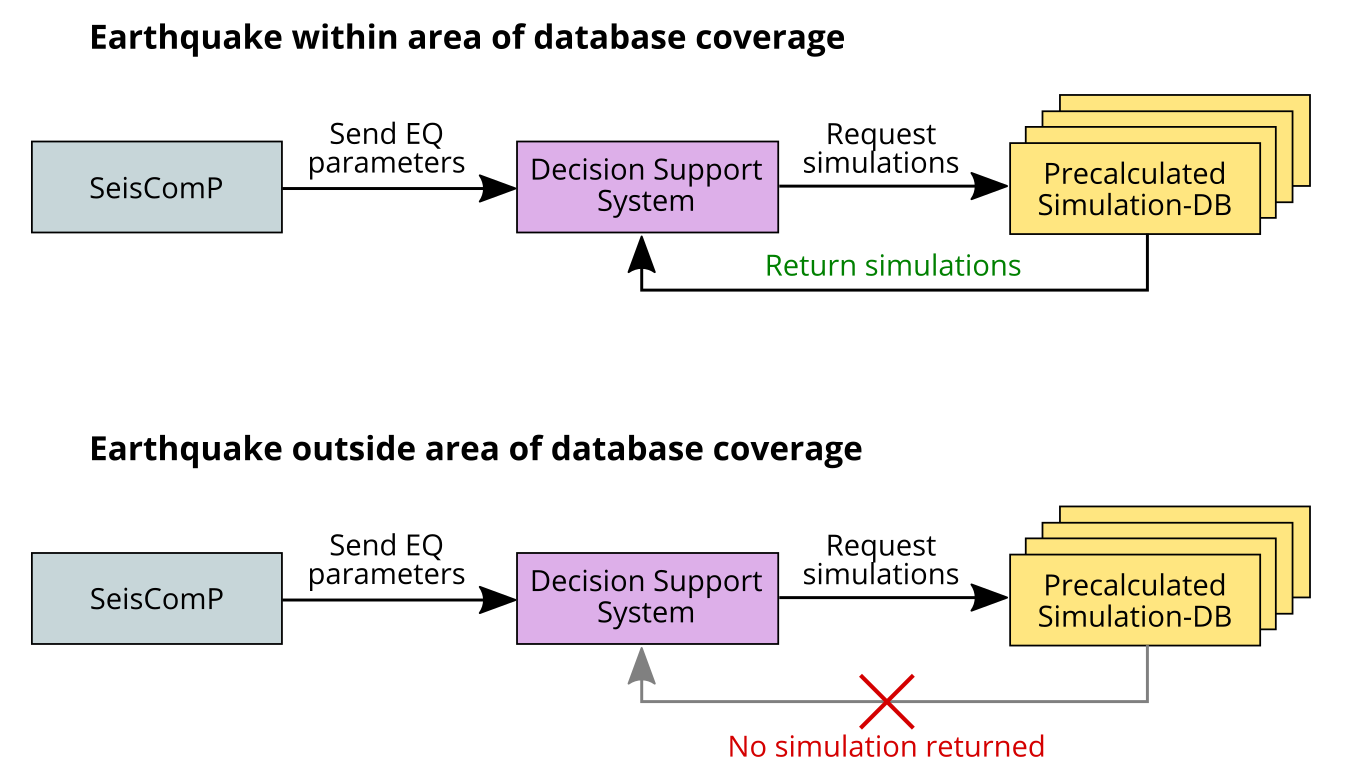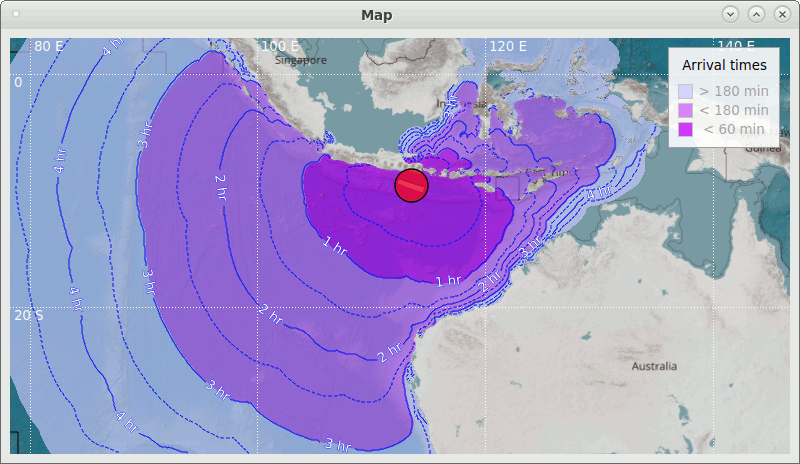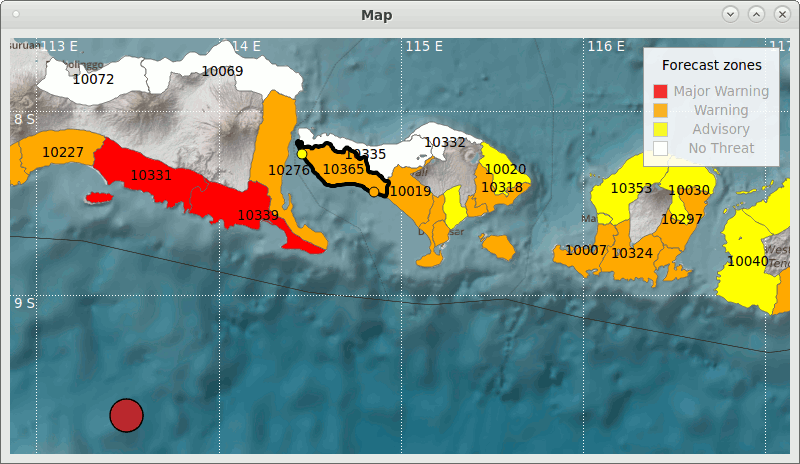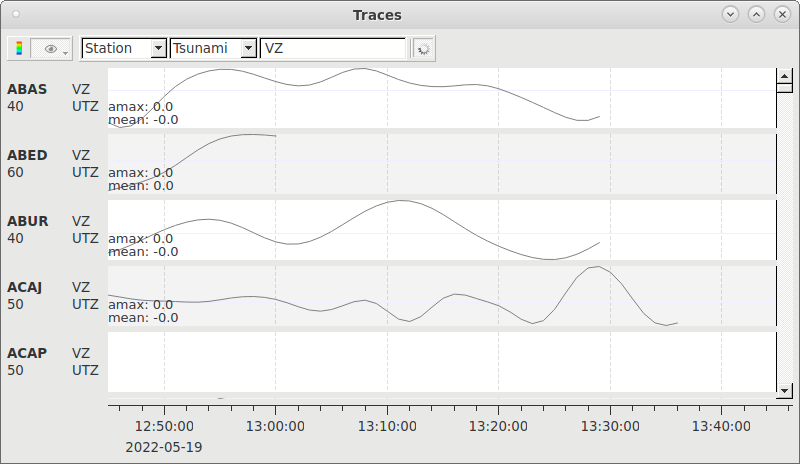Attention
This documentation refers to the single-user TOAST-legacy version which is being phased out!
Consult https://docs.gempa.de/toast-client/current/ for the online documentation of the new TOAST multi-user version.
Introduction¶
In recent times it has become evident that even though large tsunami do not happen very frequently, the implementation of effective early warning systems is crucial due to the severe impact of such events. TOAST is a software package designed precisely for this purpose. Specific tsunami warning bulletins targeted to administrative districts are generated automatically based on templates. They can be disseminated through various channels like text message, e-mail or video stream immediately after an event.
These warning bulletins are based on tsunami simulation results which are either extracted from precalculated databases or computed using a so-called on-the-fly approach. This is a unique feature of TOAST and enables it to flexibly react to unexpected events, such as earthquakes in unconsidered areas or with atypical rupture mechanism. Generating simulations adequate to the situation is done in a fully automatic way and can be complemented by manual design. Simulation results can be compared to real-time data from buoys or tide gauges even during the propagation of a tsunami. TOAST has good scalability and integrates perfectly with SeisComP to form a fully functional tsunami early warning system.
Features¶
Automatic retrieval or generation of tsunami simulations and comparison with observations
Direct connectivity to SeisComP
Automatic reception of earthquake information from SeisComP
Rapid on-the-fly simulation of tsunamis with optional GPU computation
Fast access to precalculated tsunami simulations.
Calculation and visualization of SSH, SSHMax, isochrones, arrival times, coastal wave heights
Automatic and interactive generation of simulations
Aggregation of scenarios to determine overall worst case
Configuration of stations with different types of sensors (tide gauge, buoy, etc)
Generation and dissemination of bulletins based on predefined templates
Video output and playback of simulations
Integration of oceanographic sensor data
Tsunami onset picking
Intuitive visualization of all relevant parameters
History¶
TOAST has been developed by gempa GmbH, a spin-off from the German Research Centre for Geosciences (GFZ) in Potsdam. gempa is part of the SeisComP development group. Several staff members were involved in the the German Indonesian Tsunami Early Warning System project (GITEWS) as scientists, software- or field engineers. After the implementation of the GITEWS decision support system initially used by BMKG in Jakarta it soon became obvious that the system was complex and specialized to an extent that made it hard to adapt it to other environments. This is why gempa started the development of TOAST.
Application worldwide¶
Nowadays TOAST is operational worldwide in many institutions where fast and reliable tsunami early warning is key. Some reference installations are:
Indonesia
DGMET, Oman
Geological Nuclear Science, GNS, New Zealand
Central American Tsunami Advisory Center (CATAC) established at Instituto Nicaragüense de Estudios Territoriales (Nicaraguan Geosciences Institute, INETER) in Managua, Nicaragua.
Meteorological Service Singapore (MSS), Singapore.
Concepts¶
Conventional tsunami early warning systems are exclusively based on prototypes developed within the context of more or less scientific projects. Based on the actually determined earthquake parameters, a lookup in a database of precalculated earthquake scenarios and tsunami simulations is performed, enabling prediction of arrival times and amplitudes of the tsunami wave for relevant coastlines. This approach takes a limited number of standard situations into account. In case of an atypical or unexpected earthquake, these systems fail because an on the fly simulation capability is not provided and the system is not able to adapt to the situation. TOAST supports fast access to precalculated simulations by plugins.

Conventional Tsunami Early Warning System: no simulations for unexpected scenarios are available.¶
In order to achieve higher flexibility, TOAST provides the approach of on-the-fly simulation of tsunami propagation. This enables TOAST to react to atypical situations, like earthquakes in supposedly inactive regions or earthquakes exceeding the maximum magnitude assumed for a region. For instance, before the 2004 tsunami, most experts wouldn’t have thought that a magnitude 9.3 earthquake in the Sumatra region would be realistic, and similarly for the 2011 Tohoku earthquake in Japan. Also the Fiordland earthquake in New Zealand in 2009 with a magnitude of 7.8 is an example for an unexpected event.
Spanning a wide range of possibilities, on-the-fly simulations are triggered automatically according to configuration options, and manually designed simulations can be added with a few clicks. Updates of earthquake source parameters can be immediately considered.
On the other hand, if a database with precalculated simulations is already available, it can easily be integrated into TOAST using customer-specific plugins.

TOAST: precalculated as well as “on-the-fly” simulations are available.¶
On top of that, TOAST is also able to compute worst-case-aggregations over a set of simulations. This is useful in order to get a more conservative assessment, for instance directly after a large earthquake, while the direction of its rupture propagation is still uncertain.
Tsunami generation and propagation¶
A tsunami is an oceanic gravity wave generated by submarine earthquakes or other geological processes such as landslides or volcanic eruptions. 90 percent of world-wide tsunami result from earthquakes. In deep ocean a tsunami may show low amplitude and be barely noticed, but it increases when propagating into shallower water and can cause devastating damage upon reaching the coast or harbors.
The largest tsunami are generated by subduction earthquakes at the boundaries of tectonic plates. These submarine events lift the seafloor along tenths to hundreds of kilometers by several meters within seconds to minutes. As the sea surface is raised along with it, waves are caused that travel outward in all directions away from the source area, much like ripples caused by throwing a rock into a pond.
A tsunami is made up of a series of very long waves. The wavelength and the period depend on the generating mechanism and the extension of the causing event. If a tsunami is caused by a large earthquake affecting a large area, its initial wavelength and period are larger. If on the other hand a tsunami is caused by a local landslide, both its initial wavelength and period are shorter. The period of a tsunami wave typically ranges from 5 to 90 minutes. The wave crests of a tsunami can be more than a thousand km long, and from a few to a hundred kilometers or more apart as they travel across the ocean. While the wavelength diminishes when moving into shallower water, the period remains constant.
The height of a tsunami from trough to crest in the open ocean may be only a few centimeters to a meter or more - again depending on the generating source. Tsunami waves in the deep water travel at high speeds over distances of thousands of kilometers and lose little energy in the process (except for geometrical spreading). The deeper the water, the higher the speed of the tsunami. When the tsunami approaches the coast and enters shallower water, the front is slowed down while the rear still has higher speed and thus the amplitude of the tsunami increases [1].
The so-called long wave equation describes the phase speed at which a tsunami
travels as follows:  . Here
. Here  is the gravity of
Earth (
is the gravity of
Earth ( ) and
) and  is the local water depth.
The following table shows the effect of changing water depth. The first three
columns apply in general to any tsunami, the last two correspond to an example.
is the local water depth.
The following table shows the effect of changing water depth. The first three
columns apply in general to any tsunami, the last two correspond to an example.
Water depth [m] |
Phase speed [m/s] |
Phase speed [km/h] |
Period [min] |
Wave length [km] |
|---|---|---|---|---|
10 |
10 |
36 |
10 |
6 |
50 |
22 |
80 |
10 |
13 |
100 |
31 |
113 |
10 |
19 |
500 |
70 |
252 |
10 |
42 |
1000 |
99 |
356 |
10 |
59 |
2000 |
140 |
504 |
10 |
84 |
3000 |
171 |
617 |
10 |
103 |
4000 |
198 |
713 |
10 |
119 |
5000 |
221 |
797 |
10 |
133 |
6000 |
242 |
873 |
10 |
146 |
The wavelength  and the phase speed
and the phase speed  determine
the period
determine
the period  of a tsunami through the dispersion relation:
of a tsunami through the dispersion relation:
 . Note that both speed and wave length depend on water depth,
while the period remains constant.
. Note that both speed and wave length depend on water depth,
while the period remains constant.



